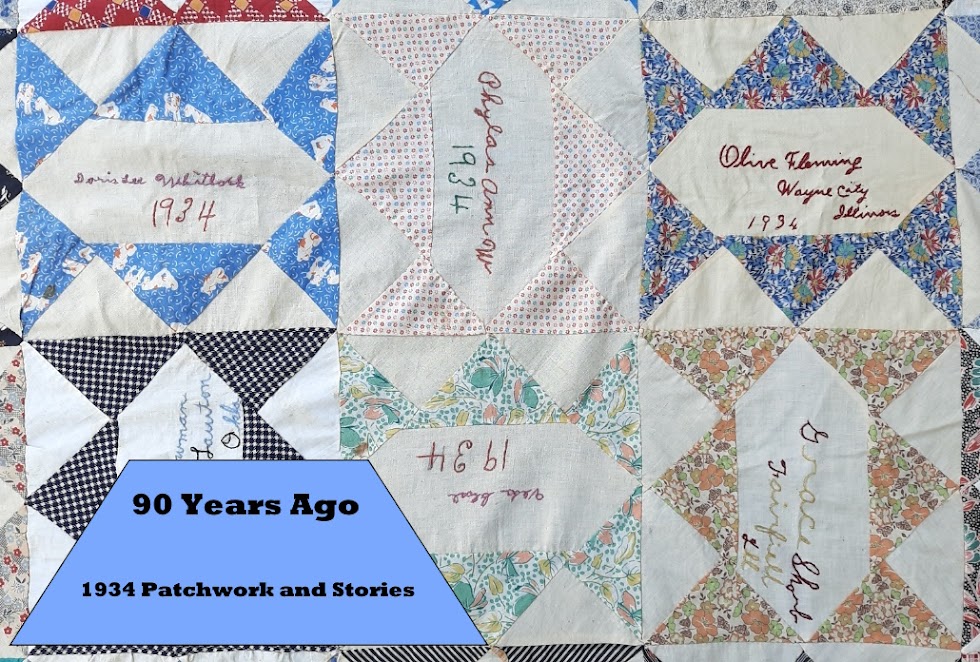This article was printed in the Oklahoma Farmer-Stockman newspaper on New Year’s Day, 1936.
Tobacco sacks: loose leaf tobacco for roll-your-own cigarettes used to come in little drawstring bags, small enough to fit in a man’s overall pocket.
While you read the following, just image how much time was involved to complete each step of the quilt making process.
The quilt maker was Nannie Long from Coal County, Oklahoma.
House furnishing projects can be carried out when the pocketbook it the thinnest – if ambition is deep-seated.
This quilt was pieced of tobacco sacks. The most of them were saved by a man who operates a filling station in our community. His collection for me totaled 265 sacks; these form the yellow pieces in the blocks, and the strips of the quilt. The remaining 125 sacks were saved by my husband. These form the black part of the quilt. This makes a total of 391 blocks used in making the quilt.
I ripped the sacks, washed them, dyed them, and put them through a thin starch. When they were dry, I dampened and ironed them one night while watching a cooker of meat. I used the “Hexagon Star” quilt pattern. Since I had no block pattern, it was necessary for me to take a ruler, measure and cut the size of each block-piece.
Flour sacks made of cambric material were used for the lining. To take the letters out, I ripped the sacks open and spread them while dry on the wash board. Then, after dipping the soap in water, I rubbed it across the sacks, until I had a thick coat of soap on the letters; rolled the sacks up tightly and let them stand an hour or more before washing them.
After washing and boiling the flour sacks I dyed them with bois d’arc chip dye. I made my dye by filling a dishpan almost full of small bois d’arc chips, covering them with water and letting them boil for a few minutes. Then I remover that batch of chips from the water and added fresh ones, repeating the process until the dye was the desired shade. Then I strained the dye, returned it to the dishpan to which I added my lining made of seven flour sacks, and let it boil twenty minutes. When the time was up I lifted the material above the water, added a handful of salt, returned the material to the dye bath, boiled it ten minutes, rinsed through several waters, and hung it in the shade to dry.
In the fall of 1933 my sister, who lives in the country not far from me, had some scrap cotton left in the field after she and her family gathered theirs, so she told me I could have half of this cotton if I’d help pull the remainder and take it to the gin. In the two days I stayed with her we pulled 275 pounds. I took the cotton to the gin myself, since I had never been before.
When the local home demonstration club organized in January, 1935, I enrolled in house furnishing. As my Hexagon Star tobacco sack quilt was one of the projects I undertook, Miss Jennie Alice Clymer, Coal County home demonstration agent, urged me to complete it in time to be displayed before advisory committee members on April 17.
The total cost of this quilt, including the dye and the thread for piecing the top, lining, and for quilting, was 65 cents.
Bois d’arc chips are made from the Osage Orange, a shrubby tree native to south-central United States. The wood chips make a yellow dye.
Nannie Long mentions a wash board and a dish pan in her preparations, so it is possible that she did not own a washing machine.
Mrs. Long remained active in women’s home demonstration clubs throughout her life, and this tobacco sack quilt got a mention in her obituary.
In the year following the first article, the Farmer-Stockman printed another pattern for a tobacco sack quilt. The method is very similar but the pattern is much easier to make.
Save tobacco sacks and make a pretty and no-cost quilt top. I saved 300 sacks, ripped and washed them, then separated them into two equal stacks and dyed each stack a different color. After they were dyed, I starched them slightly and then ironed them.
The sacks were then trimmed to equal size and sewed together in brick design to make a spread large enough to cover the top of the bed. A border four sacks wide make of strips of alternate color completed the top. The sacks made a beautiful top. - Mrs. R. R. R., Childress Co., Texas.




Unbelievable!
ReplyDelete